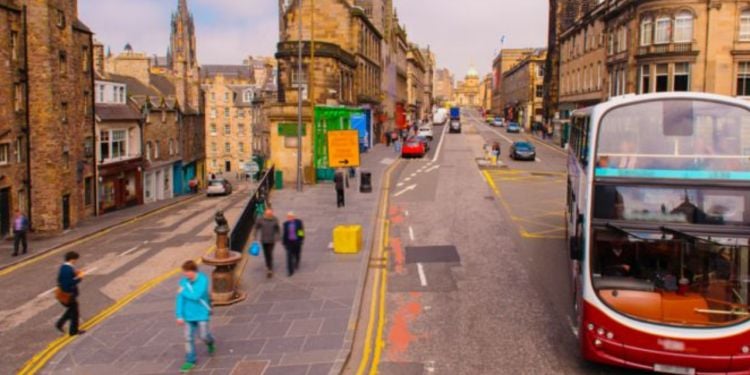
Scotland's capital city is simultaneously less densely populated than Glasgow, and very compact. It has developed an efficient transport network consisting of buses, trains and the relatively new tram network, but most of all, Edinburgh is a city you can walk or bike in.
Getting to and from Edinburgh
Edinburgh airport, just 8 km from the city, is the third biggest in all of the United Kingdom when it comes to passenger numbers. It provides both domestic and international flights, so it is a very convenient choice if you want to travel to the rest of the country by air. Depending on the time of day, the journey to the airport from the city takes about 25 minutes. You can get there by bus, tram, car or taxi.
A 24-hour airport bus departs every 10 minutes from Waverley Bridge, right in the heart of the city. You can buy tickets at the bus stop, on the bus or online.
Bus travel in Edinburgh
Edinburgh's bus network is efficient and available in most neighbourhoods, even in the outskirts. This method of transport is preferred by locals, and you will quickly adapt to the system. Most buses are also accessible for wheelchairs and pushchairs. There are also night buses that run periodically after midnight across the city.
There are two main operating companies, Lothian Buses and First Group. Lothian Buses (and its sister division, Lothian Country) serve the city and its suburbs. First Group is useful for travel to and from commuter towns and villages in Scotland's central belt. Both companies offer travel cards for frequent travellers, as well as a mobile app to help you plan your journey.
Lothian Buses only accept exact bus fare as drivers cannot give change. However, as at 2019 passengers can use their contactless cards to pay. This is capped at the cost of a Day Ticket, so you don't need to worry about being out of pocket paying this way. You can also purchase tickets on your phone via the M-Tickets app. Visit the Lothian Buses website for more detailed information on bus travel.
Tram travel in Edinburgh
Edinburgh mainly relied on its bus network until the launch of its tramway network in 2014. Nowadays the tram network is 14-kilometres long and can take you from the city centre to the airport in about 35 minutes. All trams have wifi and are wheelchair accessible with ramps and lifts being provided at each stop.
Tram tickets should be purchased before boarding at electric ticket machines located at each stop. Additionally, riders can travel using tickets purchased on their phone via the M-Ticket app, or by tapping their Lothian Ridacard before boarding.
Find out more about tram ticket prices and itineraries here.
How to travel cheaply around Edinburgh
Often buying single bus or tram tickets will cost you more than a number of saver options.
A Day Ticket currently costs £4 and can be used for unlimited journeys on Lothian Buses and Edinburgh Trams (except to the airport).
A Day and Night ticket can be purchased for £3.50 after 6 pm, and this permits unlimited Lothian Buses and Lothian Nightbuses travel until 4.30 am.
If you are commuting daily or wish to explore the city regularly, then a Ridacard is your cheapest option. A Ridacard will permit you to travel on Lothian Buses, Lothian Nightbuses, Edinburgh Trams, Airport Buses, Lothian Country City Zone buses, and East Coast Buses. This currently costs £57 in advance for a month's travel, or £53 via Direct Debit.
Trains in Edinburgh
Edinburgh's main train station is in Waverley, with its second station Haymarket located in the West End. Millions of passengers travel through every year, accessing every corner of the country but also UK destinations such as London. There are five train operators, and you can buy tickets at the station's travel centre, ticket machines and information booths.
Scotrail is the leading provider of train travel in Scotland. There are numerous commuter trains run by Scotrail that cover towns to the west towards Glasgow, the north towards Dundee and Aberdeen, and south to the Scottish Borders.
We do our best to provide accurate and up to date information. However, if you have noticed any inaccuracies in this article, please let us know in the comments section below.







Comments